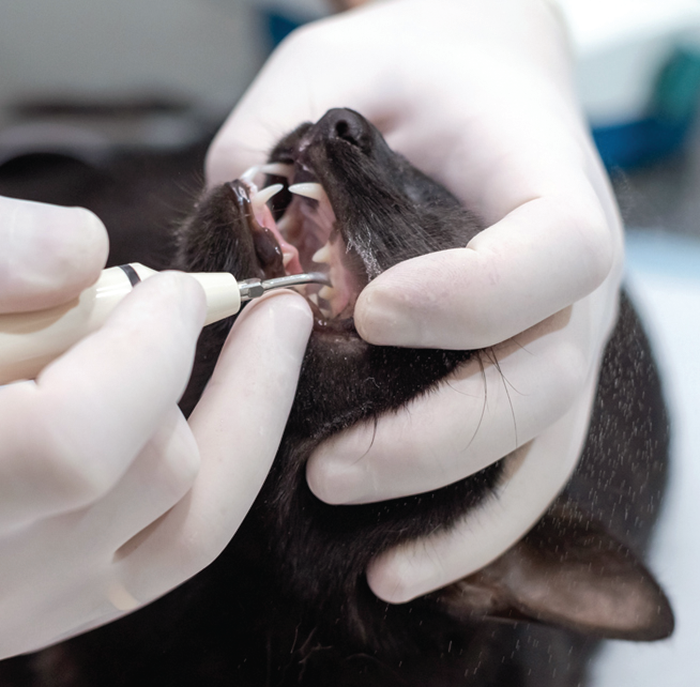Most cat owners get sticker shock when quoted an estimate for a dental cleaning for their cat. Depending on how much your cat needs done and what tools your veterinary team will be using (such as dental x-rays), the price can range from a couple hundred dollars to over $2,000. There are two primary reasons for the high cost: 1) the average cat does not receive routine dental care like many humans do, meaning most cleanings are far from quick and easy, and 2) cats must be under general anesthesia to do a dental cleaning or perform a dental procedure.
“The x-rays we take and the dental probing we perform are almost exactly the same as the ones done by the dentist for humans. What cat would allow that while it is awake?” says Nadine Fiani, BVSc, DAVDC, section chief of dentistry and oral surgery at the Cornell University College of Veterinary Medicine.
Treatment Protocol
“There are numerous diseases that affect cats’ teeth,” says Dr. Fiani, ranging from periodontal disease and gingivitis to more severe conditions such as stomatitis or resorptive lesions. “Most of them occur below the gumline and are not visible without x-rays and a very detailed oral examination,” says Dr. Fiani. “In order to identify the correct disease process and its extent, a general anesthetic is needed.”
And if your cat won’t sit still for someone to get a good look at her teeth from all angles, just imagine how she would react once the veterinarian starts trying to treat dental problems.
“Not only do we need appropriate diagnostics, but treatment is not just limited to scaling the crowns of the teeth. Cleaning below the gumline is essential. Frequently we identify disease that requires more advanced procedures. None of these can be performed with the patient conscious,” says Dr. Fiani. “In short, anesthesia-free dentistry is stressful for the animal, does not allow for proper diagnostics, nor does it treat the most common diseases we encounter in our feline friends.”
Custom Anesthesia Protocols
Anesthesia comes with a degree of risk, but your veterinarian will make your cat’s dental procedure as safe as possible. “Anesthesia is not a one-size fits all process,” says Dr. Fiani. “Each animal is assessed individually, and their medical history is taken into account when formulating a specially tailored plan. At Cornell, we are fortunate enough to have a specialist anesthesia service.”
At the time of admission, your veterinarian will likely recommend pre-anesthetic bloodwork. Say yes. This bloodwork allows your veterinarian to see how your cat’s liver, kidneys, and other organs are functioning that day to make sure they are healthy enough to process the anesthetic drugs and remove them from her body once the procedure is done. Most facilities accept bloodwork done within 30 days before the procedure. If anything is amiss, your veterinarian can adjust to make recovery easier on your cat, start intravenous fluids prior to the procedure to boost hydration, or postpone the procedure until your cat is healthier.
Most practitioners have a go-to drug protocol that they use as a basis for their patients going under anesthesia, but these protocols can be adjusted to fit the patient’s needs. In most cases, your cat will receive a “pre-medication” cocktail to provide sedation and keep her calm soon after her physical exam that morning, followed by injectable anesthetic drugs to induce complete anesthesia and gas anesthesia to maintain that state.
This method of using multiple drugs is called “balanced anesthesia” and allows your veterinarian to use smaller amounts of each drug. This reduces the risk of side effects while still giving your cat the benefit that each one brings. If your cat has a preexisting health issue, such as a heart condition, your veterinarian will likely remove any medications that are contraindicated for her case.
Your cat will likely be kept on intravenous fluids during her procedure, and sometimes before and after as well. This helps to support her kidneys as they process the anesthesia and will keep her hydrated. Other medications can be infused as well to help with specialized issues, such as pain control.
Dental Schedules
The gold standard for dental health care in pets is daily tooth brushing and an annual dental cleaning under anesthesia. Your veterinary team will be able to catch problems in the mouth sooner if they can do a thorough oral exam under anesthesia. Senior cats (ages 10 and over) should absolutely get a dental cleaning to ensure that their teeth are clean and mouth in good working order as they head into their senior years when anesthetic procedures become more risky.
“Cats are excellent at hiding their oral pain (or any other pain for that matter),” says Dr. Fiani. “There are a number of very common dental diseases that can easily be addressed with proper diagnostics and treatment. Regular examination under general anesthesia allows us to ensure that our pets are comfortable and healthy.”
What You Can Do
- Teach your cat to let you brush her teeth, keeping plaque at bay.
- Say yes to preanesthetic bloodwork to make sure your cat is healthy enough for anesthesia.
- Agree to dental radiographs so the veterinarian can assess the roots of your cat’s teeth and catch developing issues early.
- Plan to do several preventive dental cleanings over the course of your cat’s life.
- Schedule the first dental cleaning for cats at 10 to 12 years of age even if the teeth “look fine.”




